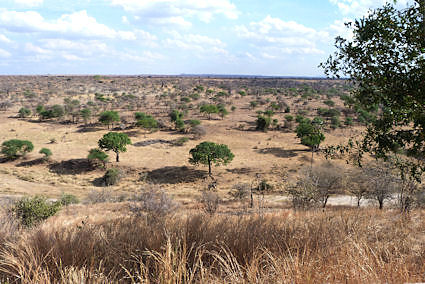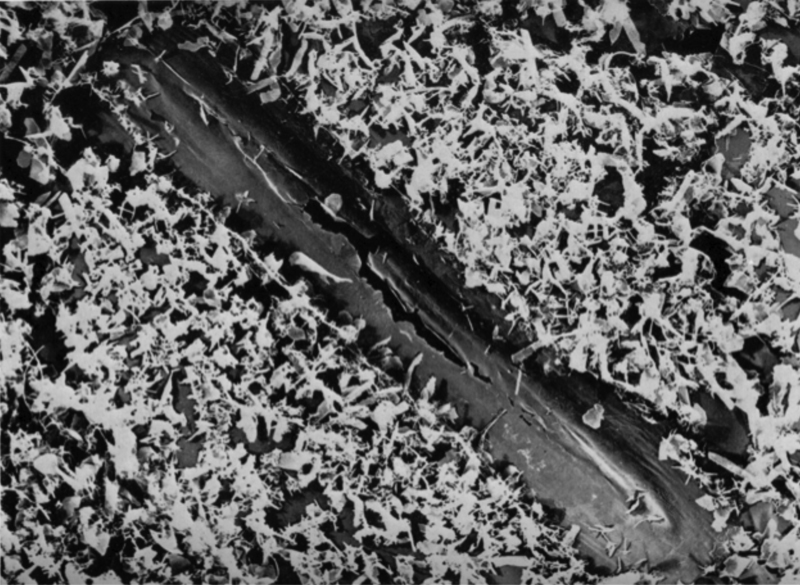Biomarkers and Molecular Isotopes

Mixed forest-grassland ecosystems can shift rapidly following climate change or ecological disturbance.
Substantial efforts have gone toward developing and applying plant wax and other molecular biomarkers to paleoclimate investigations. Molecular isotopes (compound specific δ13C and δD) of leaf waxes (alkanoic acids) from Cariaco Basin sediments revealed that deglacial vegetation in northern South America shifted between arid C4 grasslands and more humid C3 forest taxa during cold/dry and warm/wet climate intervals (Hughen et al., 2004b; Makou et al., 2007). A 180 ka record of leaf wax δ13C from the Cariaco basin revealed complex interactions between high-latitude and local tropical forcing of hydrological variability on millennial to orbital timescales (Drenzek, Ph.D. thesis, 2007; Drenzek et al., in preparation). Records of leaf wax isotopes (δD, δ13C), biomass burning markers, and inorganic proxies from Lake Bosumtwi in West Africa show abrupt non-linear responses of terrestrial vegetation to gradual climate changes, probably due to rapid shifts in fire regime (Shanahan et al., 2016; 2015). δD in leaf waxes from Lake Titicaca and low-elevation sites show that tropical Andean hydrology changed in concert with high-latitude North Atlantic climate rather than local insolation over the past 55 ka (Fornace et al., 2016; 2014). A study off the Peru Margin revealed independent variability in El Niño and La Niña conditions following the last Glacial period (Makou et al., 2010), and an investigation in the Arabian Sea reflects the potential use of leaf waxes to track monsoon changes (Dahl et al., 2005). We have also studied high-latitude climate change through development of geochemical climate proxies in marine, fjord and lake sediments. δD in leaf waxes and TEX86 from surface lake sediments in the eastern Canadian Arctic show strong correlations to surface air temperature and promise for reconstructing Arctic climate (Shanahan et al., 2013a; 2013b) and biomarkers for sea-ice diatoms accurately reflect distributions of sea ice (Stoynova et al., 2013).

Leaf waxes, seen here magnified surrounding the stomatal pore on a corn leaf, protect vascular plants from drying out in the hot sun.
Relevant Publications
- Drenzek, N., Hughen, K., Sessions, A., Eglinton, T., Atlantic Intertropical Convergence Zone variability over the last Glacial cycle, (in preparation).
- Fornace, K., Whitney, B., Galy, V., Hughen, K., Mayle, F., 2016, Late Quaternary Environmental Change in the Interior South American Tropics; New Insights from Leaf Wax Stable Isotopes, EPSL 438, 75-85.
- Shanahan, T.M., N. McKay, K.A. Hughen, J.T. Overpeck, W. Gosling, L. Miller, J.A. Peck, C. Scholz, C.W. Heil, J. King, 2016, CO2 and fire influence abrupt savanna-woodland transitions in the tropics since the Last Glacial Maximum, Nature Scientific Reports 6:29587, doi: 10.1038/srep29587.
- Shanahan, T., McKay, N., Hughen, K., Overpeck, J., Otto-Bliesner, B., Heil, C., King, J., Scholz, C., Peck, J., 2015, The time-transgressive demise of the African Humid Period, Nature Geoscience 8, 140-144.
- Fornace, K.L., Hughen, K.A., Shanahan, T.M., Fritz, S.C., Baker, P.A., Sylva, S.P., 2014, A 60,000-year record of hydrologic variability in the Central Andes from the hydrogen isotopic composition of leaf waxes in Lake Titicaca sediments, EPSL 408, 263-271.
- Shanahan, T., Hughen, K., Van Mooy, B., 2013b, Environmental controls on GDGT distributions in Arctic lakes, Organic Geochemistry 64, 119-128.
- Shanahan, T., Hughen, K., Sauer, P., Ampel, L., Fornace, K., 2013a, Environmental controls on the D/H values of terrestrial leaf waxes in the Eastern Canadian Arctic, Geochimica et Cosmochimica Acta, doi:10.1016/j.gca.2013.05.032.
- Stoynova, V., Shanahan, T., Hughen, K., deVernal, A., 2013, Insights into Circum-Arctic Sea Ice Variability from Molecular Geochemistry, Quaternary Science Reviews 79, 63-73, doi:10.1016/j.quascirev.2012.10.006.
- Makou, M., Eglinton, T., Oppo, Hughen, K., 2010, Post-Glacial Changes in El Niño and La Niña Coupled Behavior, Geology 38, 43-46, doi: 10.1130/G30366.1
- Drenzek, N., 2007, The temporal dynamics of terrestrial organic matter transfer to the ocean: initial assessment and application, Ph.D. Thesis, MIT/WHOI Joint Program in Oceanography.
- Makou, M., Hughen, K., Xu, L., Sylva, S., Eglinton, T., 2007, Isotopic Records of Tropical Vegetation and Climate Change from Terrestrial Vascular Plant Biomarkers Preserved in Cariaco Basin sediments, Organic Geochemistry 38, 1680-1691.
- Dahl, K. A., Oppo, D. W., Eglinton, T. I., Hughen, K. A., Curry, W. B., Sirocko, F., 2005, Terrigenous plant wax inputs to the Arabian Sea: Implications for the reconstruction of winds associated with the Indian Monsoon, Geochimica et Cosmochimica Acta 69, 2547-2558.
- Hughen, K.A., Eglinton, T.I., Xu, L., Makou, M., 2004, Abrupt Tropical Vegetation Response to Rapid Climate Changes, Science 304, 1955-1959.

